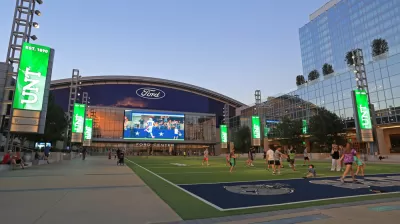The Star, the corporate headquarters of the Dallas Cowboys, opened in 2017, but this week it finally got the architecture review treatment from an unflinching critic.

Mark Lamster writes a review of the Dallas Cowboy headquarters, The Star, located in Frisco, Texas. Lamster places the tradition of the Dallas Cowboys as "America's Team" before shifting the history to the tenure of current owner Jerry Jones.
In Frisco, he has built it a genuine capital, a shimmering football Oz that emerges like a spectral vision from the blank canvas of North Texas nothingness. It is a miniature city, a 91-acre branded corporate headquarters and entertainment complex dedicated to football, consumption and — above all — profit.
The Star is not to be confused with AT&T, which opened in 2009 with a price tag of more than a billion dollars including more than $300 million in public funding. According to Lamster, however, the style of both complexes works in concert.
As at the team's AT&T Stadium in Arlington — a.k.a. Jerry World — the architectural language of the Star is unapologetically modern. It is a city of reflective surfaces, of glass and metal and white concrete that dazzles in the sun, and it is blessedly free of the kitschy, nostalgic elements common to sports design. "We talk about the past but we build for the future," a team representative told me.
Lamster also compares to a warmer, more vernacular style of architecture that is also found in Texas, and laments the auto-orientation of the complex ("understandable" but "unfortunate," writes Lamster). A follow up article by Christopher Wynn breaks Lamster's points into a tl;dr list.
FULL STORY: With The Star in Frisco, the Dallas Cowboys build a football Oz

Alabama: Trump Terminates Settlements for Black Communities Harmed By Raw Sewage
Trump deemed the landmark civil rights agreement “illegal DEI and environmental justice policy.”

Study: Maui’s Plan to Convert Vacation Rentals to Long-Term Housing Could Cause Nearly $1 Billion Economic Loss
The plan would reduce visitor accommodation by 25% resulting in 1,900 jobs lost.

Why Should We Subsidize Public Transportation?
Many public transit agencies face financial stress due to rising costs, declining fare revenue, and declining subsidies. Transit advocates must provide a strong business case for increasing public transit funding.

Paris Bike Boom Leads to Steep Drop in Air Pollution
The French city’s air quality has improved dramatically in the past 20 years, coinciding with a growth in cycling.

Why Housing Costs More to Build in California Than in Texas
Hard costs like labor and materials combined with ‘soft’ costs such as permitting make building in the San Francisco Bay Area almost three times as costly as in Texas cities.

San Diego County Sees a Rise in Urban Coyotes
San Diego County experiences a rise in urban coyotes, as sightings become prevalent throughout its urban neighbourhoods and surrounding areas.
Urban Design for Planners 1: Software Tools
This six-course series explores essential urban design concepts using open source software and equips planners with the tools they need to participate fully in the urban design process.
Planning for Universal Design
Learn the tools for implementing Universal Design in planning regulations.
Smith Gee Studio
Alamo Area Metropolitan Planning Organization
City of Santa Clarita
Institute for Housing and Urban Development Studies (IHS)
City of Grandview
Harvard GSD Executive Education
Toledo-Lucas County Plan Commissions
Salt Lake City
NYU Wagner Graduate School of Public Service





























